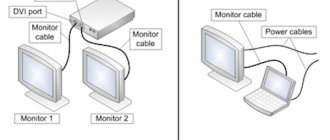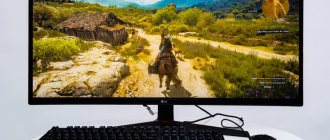Just a few years ago, the choice of a monitor for a personal computer was based on the price category, where it was clear that a more expensive device had a high-quality matrix, and a cheap monitor did not shine with characteristics. At the moment, the monitor market is divided by screen size; each manufacturer produces devices with different matrix technologies. Because of this, the purchasing choice has become more complicated. This article will help users choose the right monitor matrix type. Which screen is better to buy on the market, for what purposes and how it differs from competitors will be presented in an accessible form.
To make it clearer
Before choosing the type of monitor matrix, you need to understand the principle of its operation, as well as identify all the advantages and disadvantages. Having compiled a list of needs (for what purposes this device is purchased), it will be very easy to compare what is actual with what is desired. If you do not affect the screen size, the use of the monitor is distributed according to needs into several groups:
- Office monitor. A high contrast level is the only requirement.
- Designer's computer (photo, pre-press). Accurate color reproduction is important.
- Multimedia. Watching movies requires wide viewing angles and true black color on the screen.
- Gaming computer. An important indicator is the response time of the matrix.
The production technology and the movement of electrons between matrices is unlikely to be of interest to anyone, so this article will discuss the advantages and disadvantages, and also use data from the media - reviews from owners and recommendations from sellers. Having found out what technologies exist, all that remains is to combine them with the stated requirements and the funds allocated for the purchase of the monitor.
The state employee does not give up positions
The TN (Twisted Nematic) monitor matrix type is considered a long-liver among its competitors on the market. Due to its low price and availability, monitors with this matrix are installed in all government and educational institutions, offices of many companies around the world and in large enterprises. According to statistics, 90% of all monitors in the world have a TN matrix. Along with the price, another advantage of such a monitor is the short response time of the matrix. This parameter is very important in dynamic games, where rendering speed plays a paramount role.
But the color rendering and viewing angle of such monitors did not work out. Even upgrading the TN matrix by adding an additional layer to increase viewing angles did not give the desired results; it only added “+film” to the name of the screen type. We must not forget about energy consumption, which significantly exceeds the operating mode of all competitors.
Choosing a monitor in 2020 – which matrix is better TN, VA or IPS
Reward accrued
This material was written by a site visitor and was compensated for.
Buying a good monitor is very easy. You need to choose a more expensive model and pay several thousand dollars for it. But what to do if you don’t have that kind of money or you’re not ready to part with it. In this case, it is worth understanding the technologies that are currently on the market. So, monitors are represented by the following types of matrices: TN, VA and IPS. It is on their basis that the displays of laptops, smartphones and other gadgets are made. There are others, but they are not yet represented by several models for geeks.
The problem of choosing a monitor is especially relevant during the New Year holidays. Grandfather Frost strives to give the good boys some useful thing, and it is up to you whether the old man will make the right choice, or whether you will remember his rash step for a long time, wiping away your tears after an hour of sitting at the monitor. Let's get started. It's 2020. Which monitor to choose: expensive IPS, cheap TN or balanced VA. Let's go through the main characteristics.
announcements and advertising
2080 Super Gigabyte Gaming OC for 60 rubles.
Compeo.ru - the right comp store without any tricks
RTX 2060 becomes cheaper before the arrival of 3xxx
Ryzen 4000
series included in computers already in Citylink
The price of MSI RTX 2070 has collapsed after the announcement of RTX 3xxx
Core i9 10 series is half the price of the same 9 series
The price of memory has been halved in Regard - it’s more expensive everywhere
Viewing angles. The TN has terrible viewing angles with significant color and contrast shifts in both the horizontal and vertical directions. IPS have almost ideal viewing angles, which is why most professional monitors belong to this class. With VA, everything is not so simple: the most important thing here is to choose the right model. There are monitors on the market that are almost as good as IPS in this characteristic, and there are also those that are little better than their counterparts with a TN matrix.
Brightness and contrast. The good news is that there is almost no difference in brightness between the matrices. Unless, of course, your manufacturer decided to save on this characteristic. But the contrast ratio of TN is rather poor. Let's take a look at the table, everything is clearly indicated there.
Color quality. Everything is simple here, most TN monitors are 6-bit, which means you shouldn’t expect high-quality images from them. VA start from 8 bits, but some reach the coveted 10. As for IPS, they please with excellent performance and show the best picture.
Color spectrum. There are almost no differences between VA and IPS in this indicator. Both technologies offer up to 125% sRGB coverage and can perform well in DCI-P3. But we are talking about expensive high-quality monitors, because IPS has several trump cards in its pocket, thanks to which professionals can get 100% DCI-P3 and Adobe RGB coverage. TN trails behind, barely reaching 100% sRGB.
Prices. All this time you could see that TN matrices are simply disgusting. But when it comes to price, no technology can match cheap TN monitors. Moreover, only this technology allows the production of 240-Hz displays. VA reaches up to 200 Hz, IPS up to 165 Hz. Interestingly, expensive professional IPS monitors have a refresh rate of up to 90 Hz.
Response time. For a long time, this characteristic distinguished monitors built on a TN matrix. However, recently manufacturers have learned to make VA and IPS displays with very low response times, which allows you to feel comfortable both in single-player games and in high-speed multiplayer shooters.
We've got the basics figured out. Some experts suggest that TN should be considered the weakest technology. VA is the golden mean, and IPS is the matrix for aesthetes who prefer natural color rendition. Accordingly, according to these ideas, TN is for the cheapest monitors, VA is a compromise, and IPS is for those who have extra money. This is not to say that there is no sound grain in this statement, however, it is not so simple. Many of those who have never seen a 244-Hz matrix in operation say that it does not provide any visible advantages. Just like there is no difference between four milliseconds and 8 milliseconds. Supposedly the human eye does not see the differences. Let's take a look at a short video.
Have you already decided to run to the store for such a 240 Hz monitor? Wait, that's not all. There is such a useful thing as adaptive image synchronization technology. It currently comes in two variants: G-Sync and FreeSync. This is an extremely useful technology that allows you to create a “whole” picture, without unpleasant gaps and artifacts. Nvidia adherents unanimously declare that the most advanced and correct is, of course, G-Sync. However, recently FreeSync is not only gaining momentum, but can also become a unified standard, because Nvidia itself has opened support for red technology for its cards. See below how it works.
If you're impressed, there's one more thing to keep in mind: Each person's perception of color is different. Men are noticeably worse than women. At the same time, a very small number of people see the coveted 100% sRGB. This is where the two most important questions arise: price and purpose. If a user has the opportunity to pay for an expensive monitor with IPS technology, then he has every right to later tell how justified his purchase is, and also that he doesn’t need 240 Hz. A professional selects a monitor based on his needs, but a gamer must think carefully about whether to buy an inexpensive monitor in 2020, devoid of the technological bells and whistles of the last five years, or to get the maximum possible.
PS There is also an OLED matrix, which compares favorably with all competitors. But the prices for such monitors begin where the prices for the most advanced IPS analogues end. As many experts say on this matter: the main thing is to choose and bring the monitor home. It may look better or worse against the background of dozens of other models, but at home you will have nothing to compare with. The color scheme will quickly become familiar to you, and brightness, contrast (if they are at a good level) and dozens of other characteristics will immediately become familiar to you.
But still
Apart from office use, TN+film is the best type of monitor matrix for gaming. After all, most gamers prefer to overpay for high-performance components such as a processor or video card, but they can save money on the screen. However, do not forget about color rendering; in modern games, developers try to make the plot as realistic as possible, and without a real rendering of all colors and shades, this will be very difficult to achieve.
As a result, apart from the low price and short response time, the TN matrix will not be able to surprise a potential buyer with anything. After all, it’s very hard to ignore the shortcomings:
- Low color rendering with the inability to display perfect blacks. The defect is visible when watching dynamic films where all the action takes place in the dark - “Van Helsing”, “Harry Potter and the Deathly Hallows”, “Dracula” and the like.
- The low cost of production leads to a high probability of acquiring a defective matrix, the dead pixel of which is immediately visible, because it is painted white.
- Very low viewing angles do not allow you to contemplate the picture on the screen with a large family.
What types of monitor matrices are there?
The monitor is perhaps one of the most basic elements of a computer: it determines whether your eyes will hurt after ten minutes of use, whether you can process the image correctly, and even whether you will be able to notice the enemy in a computer game in time. And for more than 15 years of the existence of liquid crystal monitors, the number of types of matrices has exceeded a dozen, and the price range is from several thousand to hundreds of thousands of rubles - and in this article we will figure out what types of matrices exist and which will be the best for a particular task. TFT TN
The oldest type of matrix, which still occupies a significant market share and is not going to leave it. It is TN that has not been on sale for a long time - mostly improved modifications are sold, TN + film: the improvement has made it possible to increase horizontal viewing angles to 130-150 degrees, but with vertical ones everything is bad: even with a deviation of ten degrees, the colors begin to change, even inverting . In addition, most of these monitors do not cover even 70% of sRGB, which means they are not suitable for color correction. Another disadvantage is the rather low maximum brightness, usually it does not exceed 150 cd/m^2: this is only enough for indoor work.
It would seem that everything, TFT TN are hopelessly outdated and it’s time to write them off. However, not everything is so simple - these matrices have the shortest response time, and therefore are firmly established in the expensive gaming segment. It’s no joke - the latency time of the best TN does not exceed 1 ms, which in theory allows you to output as many as 1000 individual frames per second (in reality it is less, but this does not change the essence) - an excellent solution for an e-sportsman. Well, besides, in such matrices the brightness has reached 250-300 cd/m^2, and the color gamut at the very least corresponds to 80-90% sRGB: it’s not suitable for color correction anyway (viewing angles are small), but for games is the ideal solution. Alas, all these improvements have led to the fact that the cost of such monitors from $500 is just beginning, so it only makes sense to use them for those for whom minimal latency is critical.
Well, in the low price segment, TN is increasingly being replaced by MVA and IPS - the latter produce a much better picture, and cost literally 1-2 thousand more, so if possible, it’s better to overpay for them.
TFT IPS
This type of matrix began its journey to the consumer market from phones, where the low viewing angles of TN-matrices greatly interfered with normal use.
In the last few years, the price of IPS monitors has dropped significantly, and they can now be purchased even for a budget computer. These matrices have two main advantages: viewing angles reach almost 180 degrees both horizontally and vertically, and they usually have a good color gamut right out of the box - even monitors cheaper than 10 thousand rubles often have a profile with 100% sRGB coverage . But, alas, there are also a lot of disadvantages: low contrast, usually no higher than 1000:1, which is why black looks not like black, but like dark gray, and the so-called glow effect: when viewed from a certain angle, the matrix appears pinkish (or purple). Previously, there was also a problem with low response time - up to 40-50 ms (which made it possible to honestly display only 20-25 frames on the screen, the rest were blurred). However, now there is no such problem, and even cheap IPS matrices have a response time no higher than 4-6 ms, which allows you to easily output 100-150 frames - this is more than enough for any use, even gaming (without fanaticism with 120 fps, of course ). There are many subtypes of IPS, let’s look at the main ones:
- TFT S-IPS (Super IPS) is the very first improvement of IPS: viewing angles and pixel response speed are increased. It's been out of stock for a long time.
- TFT H-IPS (Horizontal IPS) - almost never found on sale (only one model on Yandex.Market, and only from leftovers). This type of IPS appeared in 2007 and, compared to S-IPS, the contrast has increased slightly and the screen surface looks more uniform.
- TFT UH-IPS (Ultra Horizontal IPS) is an improved version of H-IPS. By reducing the size of the strip separating the subpixels, light transmission was increased by 18%. At the moment, this type of IPS matrix is also outdated.
- TFT E-IPS (Enhanced IPS) is another legacy type of IPS. It has a different pixel structure and allows more light to pass through, which allows for lower backlight brightness, which leads to a lower price of the monitor and lower power consumption. Has a fairly low response time (less than 5 ms).
- TFT P-IPS (Professional IPS) are quite rare and very expensive matrices created for professional photo processing: they provide excellent color rendition (30-bit color depth and 1.07 billion colors).
- TFT AH-IPS (Advanced High Performance IPS) - the latest type of IPS: improved color reproduction, increased resolution and PPI, increased brightness and reduced power consumption, response time does not exceed 5-6 ms. It is this type of IPS that is now actively sold.
TFT *VA
These are types of matrices that can be called average - they are in some ways better, and in some ways worse, both IPS and TN. Plus compared to IPS - excellent contrast, plus compared to TN - good viewing angles. The downside is the long response time, which also increases quickly as the difference between the final and initial states of the pixel decreases, so these monitors are not very well suited for dynamic games.
The main types of matrices are:
- TFT MVA (Multidomain Vertical Alignment) - wide viewing angles, excellent color rendition, perfect blacks, high image contrast, but long pixel response time. In terms of price, they fall between budget TN and IPS, and offer the same average capabilities. So if games are not important to you, you can save 1-2k and take MVA instead of IPS.
- TFT PVA (Patterned Vertical Alignment) is one of the varieties of TFT MVA technology, developed by Samsung. One of the advantages compared to MVA is that the brightness of black is reduced.
- TFT S-PVA (Super PVA) - improved PVA technology: the viewing angles of the matrix have been increased.
TFT PLS
Just as PVA is an almost exact copy of MVA, PLS is an exact copy of IPS - comparative studies of IPS and PLS matrices under a microscope made by independent observers did not reveal any differences. So when choosing between PLS and IPS, you should only think about price.
OLED
These are the newest matrices that began to appear on the user market just a couple of years ago and at astronomical prices. They have a lot of advantages: firstly, they do not have such a thing as the brightness of black, because When outputting black, the LEDs simply do not work, so the black color looks like black, and the contrast in theory is equal to infinity. Secondly, the response time of such matrices is tenths of a millisecond - this is several times less than even that of e-sports TNs. Thirdly, the viewing angles are not only almost 180 degrees, but also the brightness hardly drops when the monitor is tilted. Fourthly - a very wide color gamut, which can be 100% AdobeRGB - not every IPS matrix can boast of this result. However, alas, there are two problems that nullify many of the advantages: this is the flickering of the matrix at a frequency of 240 Hz, which can lead to eye pain and increased fatigue, and pixel burnout, so such matrices are short-lived. Well, the third problem that many new solutions have is the exorbitant price, in some places more than twice as high as that of professional IPS. However, it is already clear to everyone that such matrices are the future, and their problems will be solved and their prices will fall.
Advantages and disadvantages of VA technology
If VA technology is compared with the cheapest matrix on the market, TN+film, then the advantages are obvious: excellent viewing angles, very high-quality color reproduction with deep blacks. Essentially, this type of photo monitor is the best in its price range. The only thing that confuses me is the response time. Compared to a cheap TN screen, it is several times higher. Naturally, a device with such a matrix will not be suitable for game lovers, since the dynamic picture will be constantly blurred.
But designers, layout designers, amateur photographers and all professionals who need to work with real color and its shades will like monitors with VA technology. In addition, the wide viewing angle, even with a strong tilt, does not distort the image on the screen. Such monitors are suitable for multimedia - watching any movies with your family will be interesting, because the screen provides the opportunity to see real black, and not its semblance in the form of fifty shades of gray.
Which is better: IPS or TN matrix?
The screens of laptops, ultrabooks, tablets and other portable computers typically use two types of LCD panels:
- IPS (In-Plane Switching)
- TN (Twisted Nematic)
Each type has its own advantages and disadvantages, but it is worth considering that they are intended for different consumer groups. Let's find out which type of matrix is right for you.
IPS displays: excellent color reproduction
Displays based on IPS matrices have the following advantages :
- large viewing angles - regardless of the side and angle of human gaze, the image will not fade and will not lose color saturation
- excellent color reproduction - IPS displays reproduce RGB colors without distortion
- have a fairly high contrast.
If you are going to process photos with a pre-calibrated monitor or do video editing, you will need a device with a screen of this type.
Disadvantages of IPS technology compared to TN:
- long pixel response time (for this reason, displays of this type are less suitable for dynamic 3D games).
- monitors and mobile computers with IPS panels tend to be more expensive than models with screens based on TN matrices.
TN displays: inexpensive and fast
The most widely used currently are liquid crystal matrices made using TN technology . Their advantages include:
- low cost
- low power consumption
- response time.
TN screens perform well in fast-paced games, such as first-person shooters (FPS) with fast-paced scenes. Such applications require a screen with a response time of no more than 5 ms (for IPS matrices it is usually longer). Otherwise, various kinds of visual artifacts may be observed on the display, such as trails from fast-moving objects.
If you want to use 3D technology on a monitor or laptop with a stereo screen, it is also better for you to give preference to a TN matrix. Some displays of this standard are capable of updating the image at a speed of 120 Hz, which is a necessary condition for the operation of active stereo glasses.
Among the disadvantages of TN displays, the following are worth highlighting:
- TN panels have limited viewing angles
- mediocre contrast
- are not capable of displaying all colors in the RGB space, so they are not suitable for professional image and video editing.
Very expensive TN panels, however, do not have some of the characteristic disadvantages and are close in quality to good IPS screens. For example, the Apple MacBook Pro with Retina uses a TN matrix, which is almost as good as IPS displays in terms of color rendering, viewing angles and contrast.
| IPS matrices | TN matrices |
If no voltage is applied to the electrodes, the liquid crystals lined up do not change the plane of polarization of the light, and it does not pass through the front polarizing filter. When voltage is applied, the crystals rotate 90°, the polarization plane of the light changes, and it begins to pass through. | When no voltage is applied to the electrodes, the liquid crystal molecules arrange themselves in a helical structure and change the polarization plane of the light so that it passes through the front polarizing filter. If voltage is applied, the crystals will be arranged linearly and light will not pass through. |
How to distinguish IPS from TN
If you like a monitor or laptop, but the technical characteristics of the display are not known, then you should look at its screen from different angles. If the image becomes dull and its colors are greatly distorted, you have a monitor or mobile computer with a mediocre TN display. If, despite all your efforts, the picture has not lost its colors, this monitor has a matrix made using IPS technology or high-quality TN.
Attention: avoid laptops and monitors with matrices, which show strong color distortion at high angles. For games, choose a computer monitor with an expensive TN display; for other tasks, it is better to give preference to an IPS matrix.
No flaws?
IPS matrices and their various modifications have been on the market for quite a long time. However, their cost is not as attractive to buyers as the impeccable characteristics of screens that use an expensive type of monitor matrix. Only Apple knows which screen is better for a businessman and designer, the president of a company or a traveler, because all of its devices, without exception, have IPS (In-Plane Switching) matrix technology.
From year to year, all kinds of technologies appear, experts are trying to improve the quality of an already expensive and high-quality matrix, as a result of which there are a number of modifications on the market: AH-IPS, P-IPS, H-IPS, S-IPS, e-IPS. The difference between them is minor, but it is there. For example, e-IPS (Enhanced) has technology that increases screen contrast and brightness, and also reduces response time. The professional P-IPS series can display 30-bit color, but it’s a pity that the user will not clearly notice this.
What is the VA matrix
It’s worth starting with the fact that for a long time screen developers tried to reduce the cost of the manufacturing process as much as possible. The result of such delights was the appearance on the market of matrices of the TN format - Twisted Nematic (translated into Russian - twisting thread-like). These screens were incredibly popular at one time, but it was obvious that the advantage of being cheap did not cover such disadvantages as poor color rendering, power consumption and low contrast.
Therefore, in 1996, developments in the field of screen production did not stop. And, as a result, a VA matrix appeared on the market for the first time, which works using vertical alignment technology. When a VA screen operates, polarized color passes through the liquid crystals of the matrix, providing significantly more attractive picture quality compared to TN.
But like any other technology, VA has been constantly improved since its release. As a result, several modifications appeared:
- MVA;
- PVA.
The first type differs from the original VA in that MVA has significantly reduced response speed and improved color rendition. PVA, in turn, is ready to boast a high level of contrast and a relatively low price. It is also worth noting that PVA is a development by Samsung. Therefore, it is found most often in its products.
No matter how different the subtypes of the VA matrix may be, they are all manufactured according to a similar principle. The design uses the principle of vertical alignment, as follows from the name of the screen type. Liquid crystals on the matrix are arranged perpendicularly to improve the passage of illumination rays through them. The second polarizer used in VA matrices blocks the passage of color. This improves contrast.
The main advantages of VA matrices include good response speed, wide viewing angles and high contrast levels. And the disadvantages are not the most accurate color rendition.
Reach your dreams
Without going into deciphering the modifications of the IPS matrix, you can see that this technology is a kind of symbiosis of VA and TN+film production. Naturally, only the advantages were selected that were embodied in one device. For example, the type of monitor matrix AH-IPS (Advanced High performance) is a direct competitor to plasma panels, which have no analogues in the world in terms of high-definition image reproduction quality. Such a serious statement was made back in 2011, but apart from the inflated price for a device with an AH-IPS matrix, it has not yet been possible to prove its superiority.
And yet, if a game lover has a question about which type of monitor matrix to choose - IPS or TN, then the right decision would be to purchase a more expensive and high-quality screen. Even though the price of the device is several times higher than its cheap competitor, spending time with your favorite toy will be more interesting. After all, realistic picture quality will always remain in first place.
IPS technology
Here the crystals are distributed evenly across the entire screen, located parallel to each other. Thanks to this solution, these matrices are distinguished by their ability to convey natural shades and excellent viewing from different angles. IPS screens have many advantages, and devices with panels in this category are very popular. They are almost universal, as they are great for gaming, watching movies and many professional tasks. In addition, recently IPS monitors are no longer as expensive as before.
What are the advantages of an IPS display:
- When viewing photos or working with graphic images, matrices in this category pleasantly surprise with their color rendition. Even the black color will not differ in any way from the original. It will not become overly saturated or take on a grayish tint. When processing photos/videos, you don’t have to worry that the final result will differ from the author’s idea during the demonstration. This matrix is noticeably better than a TN panel.
- Exposure to sunlight will not reduce image quality. Yes, there are glares if the screen is not matte, but the sun will not cause color distortion.
- The picture quality remains high and is not distorted no matter from which corner of the room you watch what is happening on the screen. Clarity and contrast are maintained. Reminder: these LCD monitors have a maximum viewing angle of 178° from any angle.
- If we are talking about devices with a touch screen, then IPS will delight you with high sensitivity. Controlling a display with such a panel is the height of comfort: you can work with drawings and drawings. The screen will respond quickly to both the finger and the stylus. Artists, designers, and architects will definitely appreciate this feature.
Possible complaints:
- The cost of IPS is significantly higher compared to TFT.
- Not as fast a response as the same TN models, although the Predator XZ271A with an IPS panel boasts a millisecond response. However, there are still few such monitors.
- Devices with IPS screens consume more energy.
Topic: Which monitor with IPS matrix to buy: TOP 10 best models
Fun games manufacturers
We will talk primarily about the Korean giant Samsung, which constantly strives to invent new technology, but it does not always succeed, because along with the quality, the buyer is also interested in the cost of the device, which for some reason tends to increase disproportionately.
By introducing single pixel separation technology, Samsung has achieved better image clarity. This is primarily noticeable on the screen when typing multi-colored text in small font. The technology was approved by many layout designers, and monitors with PVA markings quickly found fans.
The WVA monitor matrix type was an improved version of technology from Samsung, and, judging by the low cost of the devices, it competed freely in the market. The shortcoming with the matrix response speed in all devices created using VA technology has not been eliminated.
QLED type matrices (Quantum Dots)
The main developer of this technology is Samsung. QLED is the same LED screen. Only in the production of the matrix are higher quality materials used. The crystals (in pixels) are made from highly pure materials. They have a luminous flux transmission capacity of about 98%. Such screens have high brightness and realistic colors. To some extent, it is similar to OLED in terms of image quality.
Since the process of manufacturing ultrapure materials produces crystals of very small sizes, the name quantum dots was coined. This is a purely commercial name and has nothing to do with the actual size of the crystal.
When choosing a monitor or laptop, the question often arises of which screen matrix to choose: IPS, TN or VA. Also in the product characteristics there are various variants of these matrices, such as UWVA, PLS or AH-IPS, as well as rare products with technologies such as IGZO.
This review contains details about the differences between different matrices, what is better: IPS or TN, perhaps VA, and also about why the answer to this question is not always clear-cut. See also: Monitors with USB Type-C and Thunderbolt 3 connections, Matte or glossy screen - which is better?
Radical solution
The type of monitor matrix AH-IPS was of interest only to buyers in developed countries of the world. After all, for the best quality you have to pay a very large amount, which is beyond the means of residents of the post-Soviet space. And there is no point in purchasing a monitor that is slightly more expensive than a modern personal computer assembly. Therefore, manufacturers of expensive devices had to reduce the cost of technology by reducing the quality in the production of components. This is how a new type of monitor matrix PLS (plane-to-line switching) appeared on the market.
After analyzing the characteristics and studying the operating principle of the new matrix, you might think that this is just an improved modification of the PVA matrix from Samsung. This is true. As it turned out, the manufacturer developed this technology a long time ago, but its implementation occurred quite recently, when there was a huge price difference between middle-class and expensive devices, and there was an urgent need to fill the empty price niche.
Who won?
Apparently, this is the only case when in the war between manufacturers for the sales market, the buyer wins, who receives a worthy device in terms of its characteristics at a price that is quite acceptable to him. The disadvantage is the small selection of manufacturers, because Samsung has not released the technology beyond its concerns, so the Korean brand has few competitors - Philips and AOC.
But, faced with the choice of which type of monitor matrix is better - IPS or PLS, a potential buyer who decides to save money will definitely give preference to the latter. After all, in fact, there is not much difference between the devices. And if you pay attention to the fact that most mobile devices, including tablets, have a PLS matrix, which is very often presented by the seller as a more expensive IPS, then only one conclusion suggests itself.
In pursuit of perfection
Not long ago, Sharp introduced a type of monitor matrix made using IGZO (indium, gallium and zinc oxide) technology. According to the manufacturer, the material has very high conductivity and lower power consumption, resulting in a higher pixel density per square inch. Essentially, IGZO technology is suitable for the production of 4K resolution monitors and all mobile devices produced in Ultra HD format.
The technology is far from cheap, and prices for monitors and TVs with IGZO matrix are breaking world records. However, the well-known company Apple got its bearings very quickly, concluding contracts with the matrix manufacturer. This means that this technology is the future; all that remains is to wait for the price to drop on the world market.
Best choice for gamer
Having studied existing production technologies, you can without hesitation determine which type of monitor matrix is better. For games, response time and color rendition are a priority, so the choice here is limited. For those who want to save money, a device with a PLS matrix is quite suitable. Although the choice among manufacturers is small, it is possible to decide among the modifications. In addition to the standard type of matrix, the manufacturer offers an improved Super-PLS model, in which the brightness and contrast are higher, and the screen allows you to display a resolution exceeding FullHD.
But if the price of the issue is not critical for the buyer, then an IPS screen will allow you to enjoy the most realistic picture. You won’t be able to get confused by the markings, because they all boil down to improving the viewing angle and dynamic contrast. The only difference is the price - the better, the more expensive. By giving preference to a device with an IPS monitor matrix type, a gamer will not go wrong.
The superiority of IPS matrices
Unlike TN-type matrices, in IPS the crystals do not form a spiral, but rotate if they are exposed to an electric field, and they rotate synchronously. Changing the structure of the crystals made it possible to achieve such a parameter as the maximum viewing angle, which is equal to 178° vertically and horizontally. If the IPS matrix is not under voltage, the LCD molecules do not rotate. The second filter is always turned perpendicular to the first, which prevents light from passing through it. Black color display is close to ideal. If the transistor breaks down, the “broken pixel” will look black, unlike TN matrices in which it will be white. When voltage is applied, the LC molecules rotate perpendicular to their initial position, thereby transmitting light. While the color temperature remains unchanged throughout the spectrum, the colors match the image as closely as possible and convey the most correct colors from any digital media. In the picture, the IPS matrix most accurately conveys colors across the entire spectrum at different viewing angles. As we know, TN type matrices have better response than IPS type, but not always. When transitioning from gray to gray, the IPS matrix has a better response than TN. Also, IPS type matrices are pressure resistant and, unlike TN and VA type matrices, do not “blur”. We can say that monitors made on IPS matrices are an integral equipment for such professions as photographers and designers.
Recommendations for choosing matrices
In 2020, TVs and monitors based on VA matrices are in great demand and popularity because they are cheaper than IPS and are inferior in quality only in viewing angles. Therefore, it would be wiser for the average user to give preference to models based on VA type.
If you are involved in professional e-sports, especially if it is a shooter, then you are recommended to buy a monitor based on a TN matrix. Since they have a minimum response time and you will already be ahead of your competitors on the device, which will give you superiority.
If you are professionally involved in design, photography, etc. then you probably have several monitors to compare the color and quality of your work, and you will definitely need a monitor based on an IPS matrix if you do not have one.
Photo processing and graphics are a priority
It is clear that an IPS device is suitable for designers and layout designers. But is there any point in overpaying? After all, photo processing and layout involve working with colors and their shades. The response time of the matrix is not considered at all. Professionals recommend not to waste money and choose a VA type of monitor matrix. Yes, this is an old technology, yes, this is the last century, but in terms of “price-quality” criteria, matrices of this type have no competitors. And if you want to purchase some of the new products, then you can opt for a PLS matrix.
If there is a need to work on a high-resolution monitor, for example 4K, then professionals recommend giving preference to IGZO devices. Their price is not so far from the popular IPS screens, but they are undoubtedly better in quality.
Refresh rate - why do we need 144 Hz?
As in the case of the diagonal, this characteristic was once stuck for a long time at 60-75 Hz. For many years, the situation in which the monitor updated the image 60 times per second suited everyone, because this was enough for gaming at 60 fps.
But the situation has changed. Monitors with higher Hertz frequencies have begun to appear on the market, delivering more frames per second without the Screen Tearing effect. Returning to the MPG and MAG
, it can be noted that MSI also perfectly considered the trend and released many models with
144 Hz
.
This means that the picture on such monitors is potentially smoother. Needless to say, this is a good help for gaming? Especially in fast, dynamic games, where even fractions of a second matter. Again, don’t think that you can buy a cool monitor with a high refresh rate and that’s enough to get the desired 60 fps in games. This indicator must be ensured by the work of other components - video card, processor, and so on. 144 Hz will not help if the computer produces 40-50 frames, high frequency is only important if you have a powerful enough computer.
Multimedia lovers can save money
Oddly enough, but for those who like to watch movies on a monitor screen and surf the Internet, purchasing a device with a TN+film matrix is quite enough. An inexpensive gadget with an improved screen can easily replace a small TV. The problem can only appear in dark dynamic scenes, where instead of a black background the viewer will have to observe a gray cloud. If this is critical, you need to look towards VA matrices. Yes, the price is higher, but the problem with color rendering will be solved. In addition, the buyer will receive very high contrast and large viewing angles. Don’t forget about the physical resolution of the matrix – the higher it is, the better the picture.
Office option
It would seem that the universal type of TN+film monitor matrix would be perfect for working with text. But, as practice shows, working with small print behind such a screen is extremely inconvenient. And if a monitor is purchased specifically for working with large volumes of text, then you should worry about your vision. The closest technology to TN at an affordable price is VA. Regardless of the manufacturer and screen size, such a device will allow you to sit at the computer for more than one hour without any problems.
When choosing a monitor for office work, attention should be paid to both the size and physical resolution of the matrix. The diagonal of the screen for working with text should not exceed the distance from the user’s eyes to the matrix. It is also recommended to select office monitors with an aspect ratio of 4:3, because in this ratio more readable information is placed on the screen.
How to choose a matrix for a computer
The type of matrix should match the user's preferences and what he needs the computer for.
- What is the matrix for the office? Depending on the amount available for purchase, you can choose a cheaper TN matrix or an expensive VA. The VA matrix will provide high operating comfort, but even the TN matrix is suitable for standard use computers.
- What is the matrix for multimedia? When the monitor is used to watch movies, photos and games, and viewing angles matter, the best choice is an IPS matrix.
- What is the matrix for games? This depends on several questions. If you want to buy a large monitor on a limited budget, you should consider a TN matrix, but from a good manufacturer and high class. If price is not a barrier, we recommend you look into IPS or VA panels.
- What matrix for graphics? The best choice would be a VA matrix, which combines the advantages of IPS and TN matrices and provides the appropriate comfort for design work.
- What matrix for a budget computer? This is a situation in which it is worth taking a TN matrix.
When choosing a monitor, you should pay attention to many parameters, but one of the important issues is the type of matrix. It's worth choosing according to your budget and individual preferences, but keep in mind the fact that the size of the matrix affects the overall satisfaction with the programs and multimedia used, this can affect the movie and gaming experience, as well as the usability, so this a question worth thinking carefully about.
New trend: for your loved one
Having studied all existing technologies of liquid crystal screens, before choosing the type of monitor matrix, a potential buyer should get acquainted with the information obtained through user surveys in the media.
- The monitor is a durable purchase. That is, the next acquisition, with a high probability, will not be earlier than in 10 years.
- In 99% of cases, the stated requirements for equipment do not coincide with operating conditions. That is, gaming battles are taking place on an office monitor, while only news feeds are viewed on elite devices.
- Multi-connection. For convenience, 25% of users in the world connect several monitors (2, 3, 4) to one computer, and the number of such owners is constantly growing. The convenience is that each connected device has a specific role – games, movies, office, etc.
The above information allows you to rethink your earlier knowledge. It is recommended to make a purchase based not on needs, but on desire and capabilities. Essentially, you should focus on the most expensive and high-quality device that the user can afford. You can't save money here.
Differences in the design and operating principle of LCD matrices
| IPS (In-Plane Switching) | TN (Twisted Nematic) |
| The lined-up liquid crystals do not change the polarization of light when no voltage is applied to them, so no light passes through the front polarizer. The filter begins to transmit light only when the crystals are rotated 90º when voltage is applied. | The crystal molecules line up in a helical manner without tension and the polarization plane changes, transmitting light through the front filter. And when voltage is applied, the molecules rearrange linearly and block the passage of light. |
How to distinguish TN from IPS on site
If you have been provided with technical information about the laptop's equipment, it is very easy to distinguish a model with an IPS matrix. To do this, you just need to see if the image changes when viewed from different angles. During such a test, a TN display will dim and distort colors and contrast. IPS will keep the picture clean and clear when viewed from any direction.
How important is contrast and brightness?
Maximum contrast and brightness are other extremely important selection criteria.
The higher the brightness the better
A laptop whose display has a brightness of up to 200-220 candelas per m2 is suitable for use in rooms with artificial lighting. Accordingly, the lower this indicator, the dimmer the monitor is at maximum settings. According to basic recommendations, for constant work it is recommended to buy laptops whose LCD displays have a brightness of no higher than 160 candelas per m2. If you plan to use the device outdoors in natural light, its brightness should reach 300 cd/m2.
An important point in checking the screen before purchasing is to clarify how evenly it is illuminated. To do this, you need to launch any graphics editor in full screen mode and fill the canvas with dark blue or white. The resulting canvas should not have dark or light areas.
Contrast: static and checkerboard
The maximum static contrast value is a characteristic that indicates the difference between the brightness of sequentially displayed black and white colors. So, for example, with a contrast ratio of 700:1, the white color displayed on the screen is 700 times brighter than the displayed black color.
But due to the fact that the image is never only black and white, to measure the actual brightness they resort to the checkerboard method. To do this, the screen does not need to be alternately filled with white and black colors - you need to make a chessboard out of them, displaying the corresponding pattern on the screen.
The fact is that technical features do not allow in this case to set the maximum brightness for the white sectors and at the same time completely turn off the backlighting of the black ones. Therefore, the contrast gap is significantly reduced - to the optimal value of 150:1 and the ideal 170:1.
Which displays are better: glossy or matte?
In general, there is no fundamental difference, and the choice depends on the specific conditions and purposes of operation. Matte LCD monitors do not create glare or reflections because their surface has a rough structure and, accordingly, reflects much less light. However, they have a disadvantage called the crystalline effect - the image on a matte display is slightly hazy.
Displays with a glossy surface tend to be brighter, have better contrast, and produce more pronounced colors. However, such displays, depending on the lighting, can produce strong glare. This makes it difficult to perceive graphic information, strains the eyes, and leads to rapid fatigue. High brightness can save you from glare, but sometimes it is not enough. As a rule, glossy screens with a low brightness limit reflect details of the external environment.










